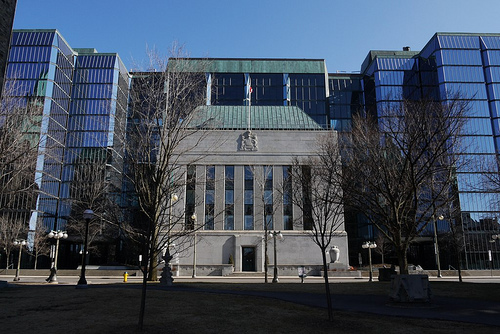In his latest Howe Street broadcast, Bob Hoye from ChartsandMarkets.com takes aim at the assumption that the Bank of Canada can control the economy and explains why gold miners and explorers can thrive during a post-bubble contraction.
Myth the Bank of Canada can manage the economy (pic source D. Neuman)
Hoye takes aim at the idea that the central bank keep the economy on track by setting interest rates. In particular, he points out to history that debunks the myth that central banking can prevent economic setbacks.
The Fed started business in January 1914 and part of the intention of having a central bank was that as lender of last resort it would then prevent the financial setbacks that proceeded recessions. So, you look at the history, there have been 18 recessions since the Fed started in 1914.The theory doesn't work.
Hoye summarizes the key talking points we hear about the rationale for central banking:
- They say they can make the economy better by their manipulations
- They can prevent setbacks
- If there is a setback, they roll in and claim that they ended it
It all adds up to a big farce according to Hoye:
The idea that a central bank can manage a national economy. There is no such thing as a national economy. Can you imagine that Canada's economy is independent of the American economy? Yet you have a central bank in Ottawa thinking it can run the economy. It's a form of madness.
Hoye suggests that if we end up being in a post bubble contraction, it will represent one more failure by intrusive economics which he believes the public will notice.
In terms of precious metals. in a contraction, he expects the senior currency, currently the US dollar, to be strong. Consequently, Hoye is not looking for a big move in gold or silver in US dollar terms. Instead, investors will get a bigger bang for the buck in the gold stocks than in the metals. He cites the case of Homestake Mining (now part of Barrick Gold) in the great depression. Hoye recounts that Homestake was the senior producer in North America during the 1920s and 1930s. Based on Hoye's take, it represented an attractive investment opportunity at the start of the great depression:
Through 1930 and 1931 you could have bought the stock Homestake for $9 share and then when it hooked up with the real price [of gold] going up, the stock started going up...There was no change in the price of gold, it stayed at $20.67 until the end of 1932. But from the $9, Homestake was up 130%.
Hoye explains that Homestake's profit margins grew as operating costs dropped during the depression. Things got even better for Homestake during the misery of the depression.
When Roosevelt started moving the price of gold up, Homestake on the $9 purchase was up to about $65 in the mid 1930s.
Hoye notes the price gains did not include dividends which reached $4.50 per share.
Going forward, if we do end up in a post bubble contraction Hoye expects the gold miners will do well, and he is looking forward to it.
Improving earnings make the gold sector companies attractive for producers, but also for many gold deposits the valuations on those would be improving as well
He concludes that this could lead to a very good speculative market for junior gold exploration stocks. Listen to the full interview here.


